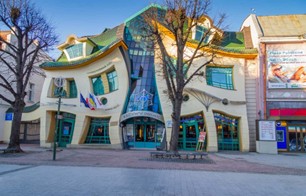THE CROOKED HOUSE
The Crooked House
By: Enzo Mario

The Crooked House, known in Polish as Krzywy Domek, is one of Poland’s most iconic and imaginative architectural landmarks. Situated on Sopot’s lively Bohaterów Monte Cassino Street, the building was completed in 2004 as part of the Rezydent Shopping Center project. Almost instantly, it became a symbol of modern Sopot, attracting visitors from all over the world who are fascinated by its surreal, dreamlike design.
The inspiration for the Crooked House came from the whimsical illustrations of Jan Marcin Szancer, a beloved Polish children’s book illustrator, and Per Dahlberg, a Swedish-born artist who lived in Poland. The architectural team of Szotyńscy & Zaleski set out to capture the playful, distorted world of fairy tales by creating a building that looks as if it were melting or swaying in a fantasy landscape. Its curved walls, warped windows, and undulating green-blue ceramic-tiled roof give it an appearance unlike anything else.
Despite its seemingly impossible shapes, the Crooked House stands firmly on modern engineering principles. The building has a reinforced concrete frame that forms its primary structural support system. This concrete skeleton allows the walls to curve dramatically without compromising stability or safety. Steel frameworks and beams were integrated into the design to create the smooth, flowing contours of the building’s façade, enabling it to achieve its signature wavy forms.
The façade itself was constructed using plaster over the reinforced concrete base, carefully shaped to follow the curved lines designed by the architects. Specially manufactured glass panels were produced to match the distorted openings, giving the windows their asymmetrical and twisted appearance. Meanwhile, the roof was clad with custom-made ceramic tiles in shades of green and blue that shimmer in the sunlight, accentuating the building’s fairy-tale character.
Internally, the building covers approximately 4,000 square meters and comprises several levels. The interior is mostly practical, with standard floors and ceilings to ensure comfort and usability for visitors and tenants. However, some interior elements, such as curved doorways and playful ceiling shapes, echo the whimsical theme of the exterior. This balance between functionality and creativity makes the Crooked House not only an eye-catching landmark but also a fully functional commercial space housing cafés, restaurants, boutiques, and offices.
To ensure safety, the building complies with Poland’s modern construction standards and fire safety regulations. Careful engineering studies were conducted to address potential issues caused by the irregular design, including water drainage on the undulating roof and the distribution of loads along curved walls. The result is a structure that, while visually unconventional, meets rigorous structural and safety requirements.
The Crooked House has become a key driver of tourism in Sopot and a powerful example of how bold architectural ideas can transform urban spaces. It embodies a playful, artistic approach to design while remaining a fully functional part of the city’s commercial life. According to the Polish Association of Architects, it has inspired new conversations about creative freedom in architecture and proved that innovative shapes can harmonize with practical urban development.
Today, the Crooked House is one of Poland’s most photographed modern buildings and a must-visit destination in the seaside town of Sopot. It continues to delight locals and tourists alike, reminding everyone who passes by that architecture can be both magical and functional.
References
Szotyńscy & Zaleski. (2004). Krzywy Domek Official Architectural Portfolio. Szotyńscy & Zaleski Architects.
City of Sopot Urban Planning Department. (2004). Revitalization of Monte Cassino Promenade: Project Report. Sopot City Council Publications.
Polish Chamber of Architects (Izba Architektów RP). (2005). Innovative Architectural Solutions in Poland 2000–2005. Warsaw: Izba Architektów RP.
Association of Polish Architects (SARP). (2006). Annual Architectural Review: Notable Polish Constructions. Warsaw: SARP Publishing.

